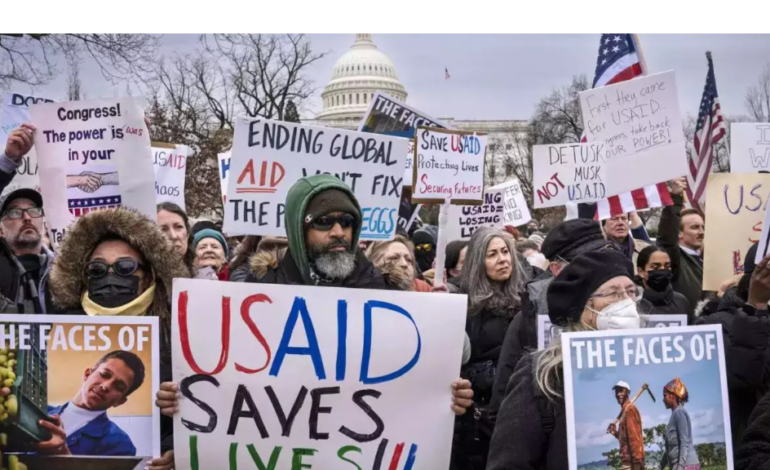
The end of USAID? What it’s shutdown means for India and the world
By Dr. Avi Verma
For decades, the United States Agency for International Development (USAID) has been a powerful instrument of American foreign policy, operating under the guise of humanitarian aid. With an annual budget exceeding $40 billion, USAID has funded development projects, health initiatives, and governance programs worldwide. However, behind its noble mission lies a more complex and controversial reality—one that has often placed India in its crosshairs.
Now, with the Trump administration pushing for its dismantling, questions arise: What happens if USAID is shut down or significantly weakened? Is this a shift toward a more self-contained America, or does it mark a turning point in global power dynamics? For India, the agency’s potential downfall is both a relief and a warning.
USAID’s Troubling Past in India
On paper, USAID has contributed to India’s economic and social development, with millions of dollars flowing into education, health, and disaster relief programs. However, its track record suggests that the agency has been more than just a benevolent donor—it has also been a vehicle for political influence and covert operations.
Take, for example, USAID’s funding of NGOs that have repeatedly interfered in India’s internal affairs. The Joshua Project, which maps religious demographics in India with a focus on conversion efforts, has been linked to organizations receiving USAID grants. Similarly, investigative groups like the Organized Crime and Corruption Reporting Project (OCCRP), which received USAID support, have aggressively targeted Indian business leaders like Gautam Adani, raising suspicions about whether their motives are truly about transparency or part of a broader geopolitical game.
Moreover, Freedom House—another USAID-backed institution—has consistently downgraded India’s democratic rankings, painting a misleading picture of the world’s largest democracy. The irony is evident: an agency claiming to promote democracy often ends up discrediting democratically elected governments that do not align with Washington’s interests.
Funding Terror by Mistake—or by Design?
The most alarming revelation about USAID is its indirect role in financing organizations linked to terror networks. In the years before the 26/11 Mumbai attacks, USAID provided $110,000 to Helping Hand for Relief and Development (HHRD), a Michigan-based charity with ties to Pakistan’s Lashkar-e-Taiba (LeT). This is the same terrorist outfit responsible for the brutal attacks that left over 170 dead and over 300 injured in India’s financial capital.
While it is possible that this funding was an oversight, the fact that U.S. taxpayers’ money ended up in the hands of a terror-linked group raises serious concerns. If an organization like USAID cannot prevent its funds from being misused, should it even exist?
The Bigger Picture: America’s Changing Foreign Policy
The push to dismantle USAID is not just about cutting wasteful spending—it signals a broader shift in American foreign policy. For years, USAID has been accused of acting as a front for the CIA, using humanitarian aid as a cover for regime change operations. From funding “color revolutions” in Ukraine and Mongolia to its involvement in destabilizing governments in Latin America, USAID’s mission has often extended far beyond humanitarian assistance.
Under Donald Trump, the agency has come under heavy scrutiny, with the former president calling it a “criminal organization” run by “radical lunatics.” Elon Musk, now heading the Department of Government Efficiency (DOGE), has echoed similar sentiments, advocating for either dismantling USAID or absorbing it into the State Department.
If USAID is shut down, it would mark the end of an era where the U.S. projected its influence under the banner of foreign aid. But does this mean Washington will stop meddling in global affairs? Hardly. Instead, we may see American influence shift to new institutions, corporate entities, and intelligence operations that are even less accountable.
What This Means for India
For India, the potential end of USAID presents both opportunities and challenges. On the positive side, it could mean reduced foreign interference in domestic affairs, fewer NGO-driven disruptions, and a greater focus on self-reliant development. Prime Minister Narendra Modi’s push for “Atmanirbhar Bharat” (Self-Reliant India) aligns well with a world where American aid agencies play a diminished role.
However, India must also remain vigilant. The U.S. is not withdrawing from global politics—it is merely recalibrating. While USAID’s closure may seem like a victory for national sovereignty, the underlying power structures that seek to influence India’s trajectory will find new ways to operate. Whether through think tanks, private foundations, or digital propaganda campaigns, the goal of shaping narratives and policies in India is unlikely to disappear.
The End of an Empire?
The potential dismantling of USAID is a symptom of a larger phenomenon—the decline of unchallenged American global dominance. As the world moves toward a multipolar order, the U.S. is struggling to redefine its role. Whether USAID survives or not, its legacy serves as a reminder that foreign aid is rarely just about charity; it is a tool of influence, power, and, at times, manipulation.
For India, the lesson is clear: self-reliance is the best defense against foreign intervention, no matter what form it takes. The end of USAID may be a milestone, but the real challenge lies ahead—ensuring that India’s growth and governance remain free from external control.